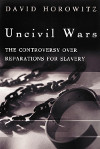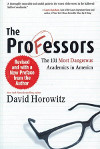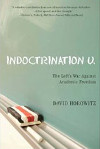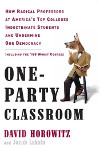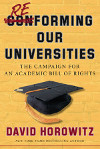One Party Classroom Reviews
Review of: ONE PARTY CLASSROOM
By David Horowitz and Jacob Laksin
Crown, $26.95, 321 pages
REVIEWED BY J. PETER FREIRE
The Washington Times – Sunday, March 15, 2009
The university has become an easy rhetorical target for any right-of-center journalist eager to write a column about outrageous behavior at universities. But few are able to draw the link between the partisanship of higher education and the decline of American intellectual culture. Few, that is, aside from David Horowitz and Jacob Laksin, whose “One Party Classroom” has just arrived in bookstores.
Compiling a veritable enemies list of the top 150 most radical classes in American course catalogs, the book is broken down into 12 chapters, each focusing on a particular school. The range is telling. Some are large state schools such as Penn State, while some are elite private schools, such as Columbia University. Every chapter begins with the history of the school’s radical curricula, then presents an annotated course catalogue. In this way, the authors show that these are not the consequence of administrative oversight, but rather the result of an effort to explicitly use the classroom as a platform for political advocacy.
“One Party Classroom” doesn’t focus so much on the individual classroom, but rather the environmental factors that make these radical classes possible. Mr. Horowitz and Mr. Laksin’s first chapter is the most damning, describing at length the Duke lacrosse rape case in which a group of Duke lacrosse players was found guilty of raping an exotic dancer, not in court, but by 88 university professors in a highly publicized statement. The only evidence the professors needed was the students’ own white skin.
This may seem like hyperbole, until you read the statements of professors like Houston Baker, professor of English, and African and African-American studies, who found this an example of “abhorrent sexual assault, verbal racial violence, and drunken white male privilege loosed against us.” English professor Karla Halloway actually published an academic paper in which she explained that justice “has an attendant social construction,” that is, the authors note, a “bias toward white male privilege.” Joined by professor Mark Anthony Neal from the Department of African and African-American Studies, among others, she moves on to make the case that the courtroom is hardly the right place to seek justice for white students’ trespasses.
Compiling these statements from the faculty is only the first step. The authors point out that the flawed logic of these professors has only been rewarded and deemed authoritative by universities all too willing to sponsor these views in classes. A professor who signed the statement damning the lacrosse players is the professor of “Attacking ‘White Supremacy’ and Global Capitalism.” Another seminar, “To Be a Problem,” includes a self-description of the professor as a “queer black trouble-maker” who asks students to consider the black community as an “outcast community.” In another program titled “Marxism and Society,” no critiques of Marxism are offered.
It is on this point where Mr. Horowitz and Mr. Laksin make their strongest case. The problem in schools isn’t simply the propaganda on offer in assigned readings. The real problem is that the radical ideologies that govern these courses also prohibits dissent. Students taking a class on Marxism will complete their requirements without ever having to think critically about it. Indeed, professors seem only to have been encouraged by their employers to teach classes that fail to draw upon a variety of opinions. The threat is not that students will find themselves converted into active Marxists as a result of a course (even if that is the stated goal). The problem is that students will leave a classroom professing to know something about which they really know nothing.
It turns out that the professors don’t know much either, thanks to the blurred line that divides academia and advocacy. As Mr. Horowitz and Mr. Laksin examine the credentials of professors, they notice a trend of underqualified political activists making their way into prominent universities.
At the University of Colorado at Boulder, for instance, Ward Churchill’s plagiarism was definitely proved by a faculty committee in a 125-page report, yet he wasn’t dismissed until two years after his statement that the victims of the World Trade Center bombing were “little Eichmanns.” Other professors claim to have published works “pending,” but these items have held that status for several years. Still others have only published rants scribbled in gibberish, or edited a volume of essays including none or little of their own work.
These examples betray an academic unseriousness, a conscious decision to pursue a reputation not for scholarly work but scintillating political insights. This theme runs through the book, as many more professors who claim they can’t help but view their scholarship as a means to advocate their politics. The departments they’ve created, or at least the ones they’ve come to dominate, are ones not trying to properly enlighten, but to politically embolden.
By focusing on the coursework, the authors provide a handy reference that represents the activist drift of college faculty. What is left to the imagination, and thankfully so, is the impact on students. Actually, it’s not left entirely to the imagination: Every chapter heading is accompanied by the cost of tuition.
The only shortcoming of the book is that Mr. Horowitz and Mr. Laksin find too much of a villain in the truly wacky American Association of University Professors. The organization, which sets standards for professorial conduct, has consistently lowered those standards from a time where professors were expected to consistently provide multiple viewpoints. The authors argue that their failure to do so has led to similarly lax standards among department heads and university administrators. But the AAUP doesn’t set wages or determine funding. The organizations through which professors come to stand at the lectern are universities, ones that have been allowed to go for far too long without enforcing standards that can only raise the bar.
It should be assumed that the reason the authors don’t pursue this point is probably for the sake of brevity. Making such a case means suggesting revamping the entire university system. But when confronted with such egregious examples as those offered by Mr. Horowitz and Mr. Laksin, one can’t help but wonder whether radical change is the only thing that can truly do away with the radical (and grossly unqualified) professors.
• J. Peter Freire is managing editor of The American Spectator.
